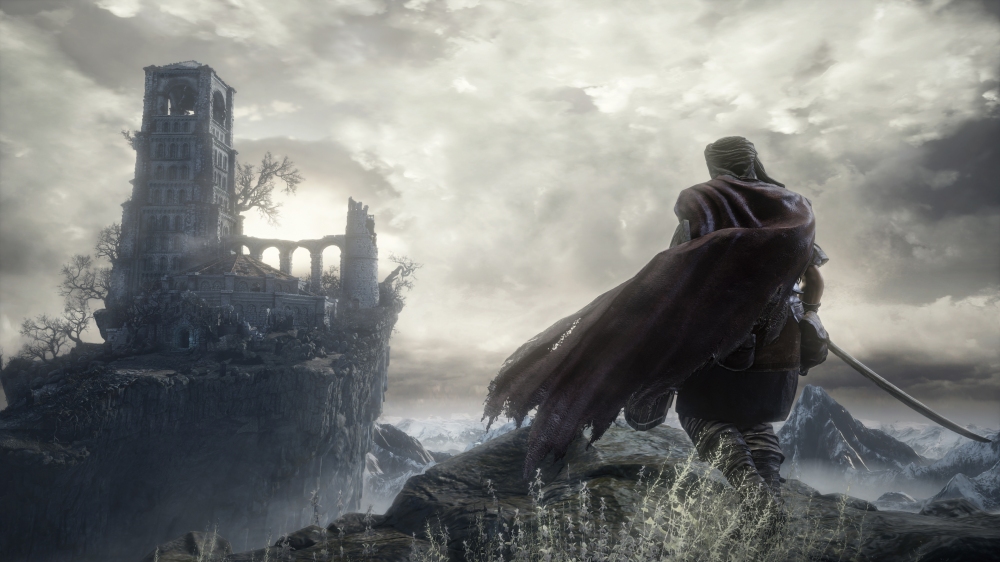
GAMES struggle to tell a good story, often the narrative is simply a premise that justifies gameplay rather than having any significance.
Dark Souls III (DS3) finds harmony between story and gameplay, bringing them together with a sombre and ever-present tone.
The game looks fantastic, with stunning landscapes, gothic architecture and the employment of pathetic fallacy throughout to give every location meaning.
This is not a rarity for Fromsoftware, but by fud; with locations like the Irithyll of the Boreal Valley, this game makes their previous incarnations look hideous in comparison.
As always, cutscenes and voice acting are rare.
The main delivery of the story is in what you see and do, with the occasional hint from rare friends or a short yet informative item description.
Nothing in DS3 is given to you on a silver platter, you must earn everything; either through the brutal but fair combat, exploring hazardous locales or deciphering hidden meanings behind a short conversation you had with an undead turtle-person.
To those unfamiliar with Fromsoftware, I must emphasize something. The combat is beyond tough. You will die, a lot. This is part of the learning process, to defeat a boss you must memorise its fighting style and know when to raise your shield or swing an axe.
For example, one boss is a giant tree that killed me immediately by sitting on me.
I also found the only way to hurt it is to attack white fungi on its wrists, ankles and waist, with each attempt at defeating it I discovered further minute details and weaknesses.
On my fourth attempt, I had chipped the tree down to half health when she decided to grow an extra arm, remove the floor and replace it with a 200ft deep hole; where the remainder of the fight unfolded.
Most boss fights in DS3 transform at the halfway mark, this is daunting but always exciting. Here, Fromsoftware have learnt from Bloodborne’s acclaim.
On my eighth attempt, I dodged all of the tree’s attacks and it was dead in less than ten minutes; but the learning experience leading up to the victory lasted well over an hour.
This pattern is not a rare occurrence, apart from two or three under-whelming bosses, progressing in DS3 is mainly about trial and error.
This may sound like it is removing the necessity for personal ability, but to get far in the game you will need to know how to use that sword/axe/club/crudely fashioned stick of concrete.
Powering up your character is vital.
Levelling up costs souls which are earned by defeating enemies, if you die you drop all of your souls, die again without picking them up and they are gone forever.
It’s that old familiar recipe with an acute balance of risk reward elements.
When you level up you get to increase one of nine statistics such as health, endurance, magic you get the picture.
It is not complicated, but the cost of leveling up steadily increases, so you must decide what to specialise in early or you will be useless at everything.
As satisfying as the gameplay is my favourite aspects of the game are the locations.
Dark Souls has always been clever with its level design.
As it has been with each of the previous games, near the start of each major section you will find yourself at a commanding view point.
From here you can see many different terrains, villages and interesting buildings far in the distance.
This view point is the closest the game ever gets to having a map screen, because if you can see somewhere interesting, odds are you can go there.
It is a wonderful feeling exploring a bastion you spotted on the horizon yesterday, especially when you mistook it for a simple backdrop.
The third entry in the Dark Souls series, DS3 has been made in a mould familiar to everyone who has every played a game made by Fromsoftware.
This may be a trademark for quality and will undoubtedly help sell many copies, but it is also DS3’s greatest weakness.
As fantastic as it is, the series has become fatigued.
Considering the tone, narrative and motive-to-play depend on our intrigue, the game suffers from its lack of originality over previous entries.
Perhaps I’m just upset this is the end, or maybe I’ve faced off against one too many knight dudes in cathedrals.
Instead of introducing anything new, the enemies and the cathedrals just seemed to get bigger. I enjoyed it, but when I entered new game + (NG+), it really hit me.
This is the apex, Dark Souls 4 would not work because the series has nothing more to say.
Fighting knights, monsters and monster-knights in a decaying gothic world has been perfected here.
Anything more is tiresome. On my NG+ playthrough it seemed like Fromsoftware had made only the tiniest changes to difficulty and it wasn’t enough. I’m happy with the 80-something hours I’ve had in Lothric but I’m not picking up the controller again.
This is goodbye Dark Souls. Now if it’s okay with you, I’m going to hunt down some beasts in Bloodborne.
Positives:
+Combat
+Level design
+Use of mysticism
+Complex boss designs
Negatives:
-Feels too familiar
-A few bosses are too easy
-New Game + doesn’t shake it up enough
9/10
Developed by: Fromsoftware
Published by: Namco Bandai
Platforms: PC, PS4, Xbox One
Try if you like:
Castlevania: Symphony of the Night, Bloodborne, Demon’s Souls, Salt and Sanctuary,
The Witcher 3: Wild Hunt
One comment